Sri Ksetra (Thayekhittaya in Myanmar), one of the ancient Pyu capitals of Myanmar, lies five miles south-east of Pyay on the left bank of the Ayeyarwady and about 180 miles north-west of Yangon. The founding of the city is popularly attributed to the reign of Duttabaung as early as the 101 st year of religion, that is, some two thousand four hundred years ago. Local chronicles relate the legend that the city was built for Duttabaung by Sakra, Lord of the devas, with the help of Gavampati, Rishi, Naga, Garuda, Candi, and Parame- swar. Standing in the center of a piece of pleasant level ground Sakra described a circle by means of a rope dragged round by the Naga. On the land thus encircled was founded the golden city of Sriksetra as glorious as Sakra’s own abode, and Duttabaung was raised to the throne and anointed a king. In course of time, the king encountered Princess Panhtwar of Beikthano who defiantly repelled his invading forces several times through miraculous strategem. Ultimately she was defeated and brought captive to Sri Ksetra. The chronicles also mention the uneventful reigns of Duttabaung’s successors and the fall of Sri ksetra after about five hundred years of its founding.
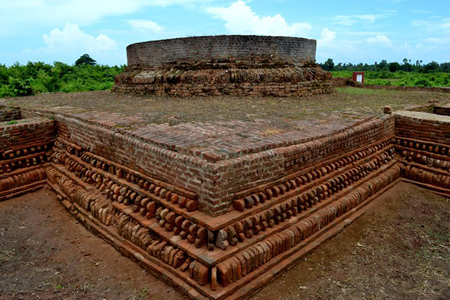
Archaeological discoveries, however, indicate that this city attained its height of prosperity between the fifth and ninth centuries. The Pyus were Tibeto- Myanmar speaking people who, being the early immigrants into Myanmar, were already settled in the central part of the country by the beginning of the Christian era. After several centuries they gradually merged with Myanmar and the Pyu language became defunct. So it is not possible yet to decipher most of the Pyu inscriptions to unravel the history of these people nor to substantiate the legendary traditions handed down from generation to generation. Fortunately, the cultural heritage of these ancient people could be revealed from the wealth of archaeological remains brought to light by exploration and excavation. Sri Ksetra is one of the thoroughly explored sites in Myanmar, intermittent excavations having been conducted since 1907 and intensive digging carried on from 1964 onwards.
Tourists coming to Sri Ksetra from their trip to Myanmar can discover that the site shows its close association and contact with South India. This can be seen in the monuments, mainly of a religious character, which dominates this ancient site.
The city is roughly circular in shape. It is encompassed by a high fort wall of large baked bricks, the circumference being eight and a half miles. Some sections of the massive wall still stand to a height of fifteen feet. As in Beikthano, each gateway has rounded comers where the fort wall turns inwards to form long barricades on either side of the entrance passage. In the center of the city lies the palace site, a rectangular enclosure, 1,700 feet by 1,125 feet, now covered with thick vegetation. The northern half of the city is a low plain dominated by rice fields whereas the southern half is comparatively high, rising gradually beyond the fort wall towards the hill range to the south.
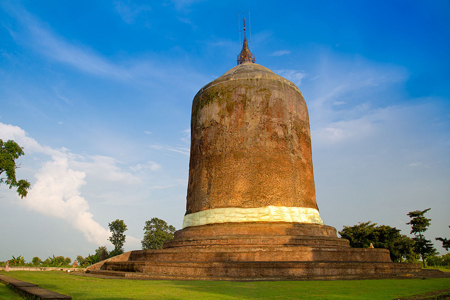
Most of the ancient ruins lie in the southern sector of the city and also outside the fort walls while burial mounds are to be found scattered throughout the locality. Among the conspicuous monuments are three tall stupas, the Bawbawgyi, the Payagyi, and the Payama, lying respectively to the south, north-west, and north of the city wall. The Bawbawgyi, 153 feet high, assumes a cylindrical shape above five low circular terraces of which two are buried under the debris. It has a conical top surmounted by a modem hti (umbrella). This type is apparently evolved from the hemispherical stupas like the Sanchi and Amaravati topes of India. An intermediary stage between the semi-circular dome and the elongated mass appears on the sculptured stone slab which was used as a cover of the square relic chamber in Khin Ba mound. The Bawbawgyi; however, is not entirely solid as might be suggested by its exterior view. The cylindrical body is hollow up to about two-thirds of height and has one opening at the base and another aperture high up in the opposite wall. The Payagyi and the Payama are much alike in having high conical domes. The absence of mouldings and elaborate architectural motifs denotes the antiquity of these Pyu stupas. Exceptions are however discovered of stupas with receding terraces and tapered moldings as in the modem pagodas but these are of
comparatively diminutive dimensions. On the evidence of the clay votive tablets and epigraphic finds recovered, the Bawbawgyi may be assigned to 6th-7th century.
A variant type of solid stupa was found in Gwebindet mound. Here the cylindrical body stands on a square base, seven and half feet high, which is reached by a flight of steps on each of the four sides. The walls of the base are decorated with clay plaques each bearing a figure of a man on horseback.
Among the hollow types of pagodas the Bebe, the Lemyethna and the East Zegu possess notable architectural features though not of great height. The Bebe has a small square sanctum with a porch facing east. Above this hollow cubicle rise three receding terraces on which stands a plain cylindrical pinnacle with a rounded top. A sculptured stone slab bearing a seated Buddha flanked by a disciple on either side rests against the west wall. The side walls have pilasters and false arched doors on the exterior and arched niches inside. This structure is a prototype of the early Bagan temples. The East Zegu temple is a little bigger than the Bebe, the ground plan is 27 feet by 24 feet. Facing east, it has prominent projections on all sides decorated with pilasters and arches. The superstructure, however, is lost to us. It originally housed a stone slab bearing the image of Buddha in relief. The Lemyethna with four entrances is also a small’ square temple, each side measuring 22 feet 5 inches. It has a central square mass against each side of which was originally placed a stone slab bearing a seated Buddha image. The one on the east is now missing. It has a terraced roof but the pinnacle has disappeared.
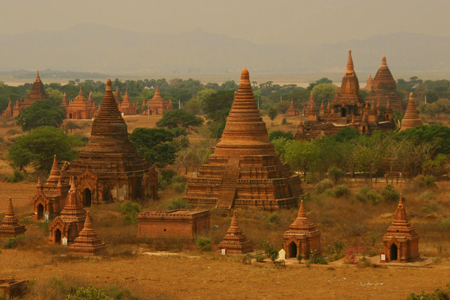
A narrow cave-like structure known as the Yahanda-gu has a vaulted roof and three entrances, one at each end and a third on the east side. Set against the west wall are two stone slabs bearing eight seated Buddhas in a row. The Payataung, a larger square edifice surmounted by a stupa measures 38 feet square at the base. The structure is solid though pilasters and arches are decorated on all sides.
Many ruined structures have been exposed by excavation but some of these are so dilapidated that the original ground plans could not be traced. At Subokkon is a small temple with only one entrance similar to the Bebe. The West Zegu, from the remains of its basement, appears to be a square temple with two entrances on the east leading directly to the square sanctum which is surrounded on the other three sides by a corridor. On the outer walls of the north and south sides of the corridor are small niches of irregular size. The remains of a temple at Shwenyaungbinkon exhibit the prototype of the temple architecture at Bagan. Here the structure consists of a porch, an anteroom and the main hall. The porch and the anteroom occupy a single compartment divided only by a stone threshold one foot wide. The most significant architectural feature is the provision of niches in the walls which are decorated with arch pediments similar to those at Bagan temples. The plaster over molded bricks have entirely flaked off but the bare outlines of the decorative arch testify the high artistic achievement in Pyu architecture.
Recent excavations have exposed at a mound near the Shwedaga gate in the north-west sector of the city wall the basement of a large structure which has a quadrangular hall-and a vestibule facing east. The hall measures 105 feet by 77 feet, while the vestibule is made of three diminishing projections having an overall length of 60 feet. It stands on an earthen plinth lined with a thin brick wall up to 6 feet, from which height raises the external walls having considerable thickness. The superstructure was apparently constructed of wood as evidenced by the recovery of numerous iron nails. The debris revealed two subsequent reconstructions at the same site though on a smaller scale than the preceding structure. A similar huge building was also unearthed near the Payama pagoda. Here the vestibule has two projections. Owing to the advanced stage of deterioration it is hardly possible to ascertain the original structural form.
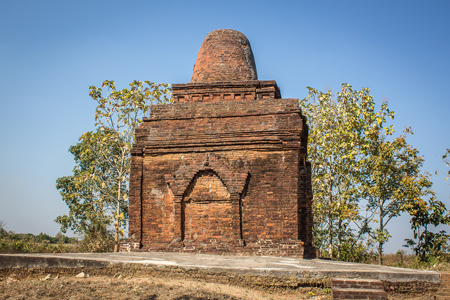
Explorations and excavations in and around the city yielded valuable antiquities some of which are preserved in the site museum at Hmawza village and others removed to Yangon for exhibition at the National Museum. Among the remains of works of art are fine pieces of stone sculpture pertaining to Buddhist as well as Hindu themes. Buddha images are generally carved in relief on huge stone slabs. Unfortunately, most of them are mutilated, having been neglected for centuries before they were discovered and preserved. One slab found in 1906 near the Bawbawgyi pagoda bears a Buddha seated with overlapping legs on a low pedestal and the hands in meditation pose. A bowl rests on the palms of the hands. A makara back-slab with a circular top is decorated behind the Buddha figure. On either side is a seated disciple but the one on the proper left of the Buddha is damaged beyond recognition. The slabs now preserved in the Kyaukka Thein (ordination hall) and the monastery in East Hmawza are also badly damaged. Each bears a seated image of the Buddha in earth-touching attitude flanked by a disciple with hands in adoration posture.
In the Bebe temple, the seated figure of Buddha in relief has his left hand in the unusual attitude of touching the earth while the right hand is in the lap. The seat is a double lotus throne below which is a line of writing in Pyu which has almost entirely flaked off. Flanking the Buddha on either side is a disciple in adoration attitude.
The sculptured slab from East Zegu temple depicts the scene of the First Sermon. Buddha is here seated on a low pedestal with the right leg placed on the left, while the left hand is stretched and rests on the left ’knee. The right arm is broken below the elbow but it seems that the hand was originally raised towards the breast. A standing figure with a headdress and holding an object which looks like a fan stand on either side of the Buddha. The lower portion of the stone slab bears a cakra symbol flanked on either side by a deer and two seated figures in adoration attitude. The two disciples on the proper right look like monks while those on the left with headdresses are laymen.
In the Lemyethna temple, the stone relief placed against the southern side of the central square pillar bears a seated Buddha flanked by Bodhisattvas. The Buddha has his left hand resting on the left knee and the right hand on the lap. The head of the Buddha and the figure on the left are damaged. The Bodhisattva on the right is apparently Maitreyya. These large stone reliefs bear marked affinity with the Gupta art and may be dated about the 7th century.
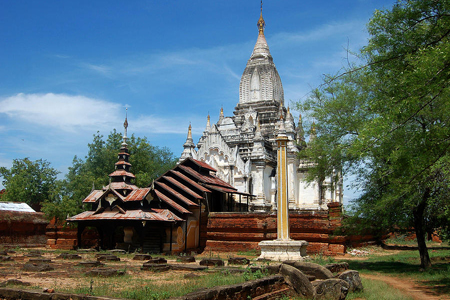
Smaller stone sculptures discovered from various sites within the city are exhibited in the site museum. Among the finds from Shwenyaungbinyo mound one slab, 15 inches high, bears in relief the nativity scene. Queen Maya standing in the center holds a branch of the sal tree while her sister Mahapajapati supports her on her left. The Bodhisat stands erect on the right of her mother. Queen Maya and her sister are in tribhanga pose, that is, their bodies are not erect but slightly bent to assume the graceful pose of “ three-bended ’’body. Another stone slab depicts the episode of the taming of the Nalagiri elephant by Buddha. Yet another interesting sculpture, 13 1/2 inches high, portrays the Buddha preaching his first sermon in the deer park. The Buddha is crowned by an umbrella and is seated on a lotus flower supported by its stalk. His hands are in the dhammacakra mudra. On each side of the Buddha is a kneeling monk with the hands in adoration attitude, representing the group of five monks who were present at the first sermon. Below the lotus seat of the Buddha are two gazelles facing towards a wheel placed on a stand in the center. On the right of the deer in the lower panel is the Brahma possessing four heads of which only three are sculptured. The other kneeling figure on the left side symbolizes the Sakra, king of the devas. These sculptures also bear Gupta influence but owing to the Mongoloid features of the figures they are perhaps later than the large sculptures by a century or two.
A more elaborate sculpture of the Dhammacakra scene was discovered in 1927-28. The uppermost panel is divided, by the sikhara (pinnacle) over the arch above the central figure, into two compartments, in each of which are two standing figures. The inner figure in either compartment is the Buddha while the outer one, with two visible heads, represents the Mahabrahma. In the middle tier is the Buddha seated cross-legged on a lotus in the dhammacakra mudra within an arched niche surmounted by a pyramidal spire. The attendants in monastic robes, are kneeling with their hands in adoration attitude and are also on lotuses within smaller arches. The lower panel bears not only the symbolical wheel with a couchant deer on either side but also two three-headed Brahmas kneeling on stools. Below the deer are two other figures, probably devotees, each holding an object placed in a vase the stand of which rests on their slightly raised knees. This sculpture, now in the National Museum at Yangon, is assigned to the 9th century.

Large single sculptures in the round are rarely found at Sri Ksetra. One remarkable exception is the Buddha image in stone from the Kanwetkhaungkon mound. The head of these figures is missing. It is seated in the meditation posture with the two hands placed on the lap. It has a fairly big rectangular pedestal round which is inscribed a long inscription in Sanskrit as well as Pyu. The Sanskrit portion is traceable to the Gupta script but may be assigned to a later date, that is, the 7th century.
Some of the sculptures discovered are distinctively Mahayanist. A large stone slab found broken in several fragments in 1926 bears the relief figure of a Bodhisattva seated in a carved niche. He sits on a throne with the right knee raised and the left leg stretched downwards. The right hand is missing; the left-hand rests on the left knee. He wears a headdress, armbands, and anklets. The stone slab is 6 feet 2 inches high and 4 feet 2 inches wide.
An interesting sculpture of a female deity, probably of the Mahayanist sect, was unearthed at a mound in the north-west sector of the city near the Shwedaga gate in 1965. It is broken into two portions, the entire height is 6 feet 9 inches. The deity sits on her folded legs with her face fully exposed to normal view but the body, in profile, facing the right side of the thick slab. Her left hand, holding what looks like a spear, is raised while the right hangs by her side. She is flanked on either side by an attendant. Four kneeling figures in adoration attitude are portrayed in the lower panel and at the bottom are six grinning female demons on their knees apparently attending on the deity.
A very extraordinary sculpture, probably of a dvarapala (guardian), was recently discovered in the course of excavating a site within the rectangular citadel.
It is a bulky figure standing on a crocodile, partly damaged, with the left hand raised to the head and the right placed on the bent right knee. The peculiar headdress looks like a bird with spread wings. A chain hangs from the buckle of his belt and the back of his loin.
The fact that Brahmanism prevailed at Sri Ksetra side by side with Buddhism is attested by the discovery of stone sculptures pertaining mainly to the Vishnavite sect. One sandstone slab bears, in bold relief, the standing figure of Vishnu with his consort Lakshmi on his right side. The top of the slab is broken and both the heads are missing. One hand of Vishnu originally holding a conch is damaged and the other holding a cakra is also partly broken. He stands on a Garuda with outspread wings and a tail, while Lakshmi is on a full-blown lotus. She holds a bunch of lotus flowers (or a defaced trident) in her raised right hand and hangs her left hand by her side. Both figures are adorned with ornaments.
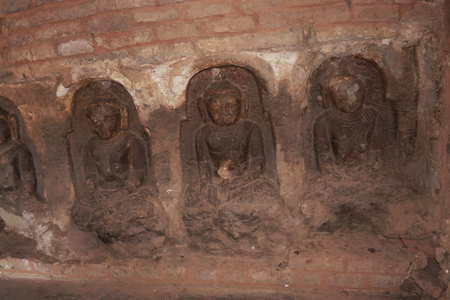
In a field near Kalagankon mound were found two sandstone sculptures. One slab represents four-armed Vishnu standing on a mutilated Garuda. The other depicts Vishnu reclining on the serpent Ananta. Three lotus flowers stem from the navel of Beikthano. On each lotus is a seated figure, the first representing Brahma, the middle one Beikthano and the third Siva.
Many statuettes and ornamental objects of gold, silver, and copper were brought to light by excavations. Among the finds from the relic-chamber in Khin Ba’s mound is a gilded silver casket, cylindrical in shape. It is embossed with the last four Buddhas of the present world cycle seated in the earth-touching attitude in the Gupta style. Between the Buddhas are four standing disciples, also in relief. A trunk of a banyan tree rises from the center of the flat lid. Originally it was adorned with twigs and leaves. Around the top of the rim is a line of Pyu-Pali inscription in South Indian characters which identifies each Buddha by name viz., Gotama, Konaga- mana, Kakusandha, and Kassapa in the Pyu form of writing. Likewise, the four disciples are also identified by a short line of Pyu below their feet. An extract from the Vinaya Pitaka follows the name of each Buddha. The names of probably the donors, Sri Prabhuvaman and Sri Prabhudevi, are also inscribed at the bottom. The base of the Vishnu and Lakshmi casket is missing.
There is also a smaller casket in the form of a cube without the lid and base. This also has a meditating Buddha on each side in beautiful repousse. Other objects of interest include miniature pagodas of silver with multiple tiers of flat circular umbrellas, gold and silver caskets with lotus knob or twin-goose resting on the cover, models of boats, ducks, deer, butterflies, lotus flowers ; gold and silver rings : necklace of elephants in jadeite and numerous beads of carnelian, amethyst, crystal, quartz, agate and glass.
Very fine pieces of bronze were also discovered at Sri Ksetra from time to time. A four-armed Avalokitesvara image was found near Bawbawgyi pagoda in the open season of 1911-12. It stands gracefully in the tribhanga pose but unfortunately, it is somewhat damaged. The two feet are missing and the left hands are broken off above the elbow. One right hand is in the ‘fear-not ’ attitude while the other one holds a bundle of palm-leaves tied round with a string. It wears a necklace, armlets and a girdle below which falls a sash tied in a knot on the left hip. The Dyani Buddha Amitabha in the elaborate headdress distinguishes the statue as Lokesvara.
Another identifiable bronze statuette in the round is that of Maitreyya. It bears on its socle an inscription the legible portion of which reads ba: Maitreya ba :
The most spectacular find of bronzes was made during the excavation at a mound near Payama pagoda in the field season 1966-67.
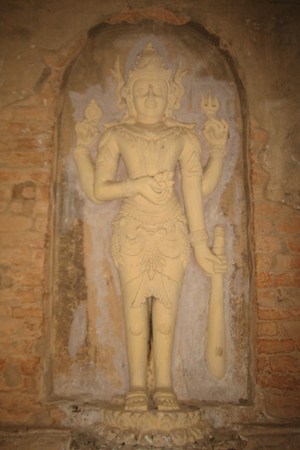
Chinese annals mention the visit of a Pyu mission including a musical troupe to their capital about 802 A.C. Concrete evidence to support the fact that there were accomplished artists in the Pyu city of Sri Ksetra was obtained by the discovery at that site of small bronze figures, every 4 and 1/2 inches in height. One is a flute player, one a drummer, one a cymbal clapper and the fourth a dancer. The fifth figure which is half the size of the first four looks like a dwarf clown carrying a sack on its back. The heads are large for the size of the figures but the bodies are of fine proportion. They are well dressed and bedecked with ornaments. All of them assume most animating postures in consonance with the performances they are engaged in. It is regrettable that the first four figures are lost through burglary at the site Museum where they were temporarily exhibited before the close of the excavation.
Together with those bronze figures were unearthed five bronze Buddhas and an ornately molded bronze bell, eleven inches high. The bell is evidently of Pyu workmanship as testified by two emblems of srivatsa, carved in relief, which is commonly found on Pyu coins.
The earliest inscriptions in Myanmar are found at Sri Ksetra. The alphabet derived from South India is more closely allied to the Kadamba alphabet of Vanavasi and the Pallava script of Andhra. Two gold plates from Maung Kan’s field in Lebaw village and another manuscript inscribed on twenty gold leaves, datable to the 5th century, from Khin Ba’s mound consist of excerpts from the Abhidhamma and Vinaya. Likewise, a small stone slab from Bawbawgyi bears a Pali inscription taken from the Abhidhamma. A very recent discovery of a stone slab, unfortunately badly flaked and weathered, was made near the Shwedaga gate. From the fragmentary lines could be read extracts from three popular Pali recitations in verse namely, the Mangala Sutta, the Ratana Sutta, and the Mora Satta. It is datable to the 6th or 7th century. These documents by themselves suffice to establish the fact that Theravada Buddhism was flourishing early at Sri Ksetra.
There have also been found numerous votive tablets of clay-bearing Buddha figures and inscribed with the opening words of the Buddhist act of faith ‘ Ye dhamma hetuprabhava’. . . Another important inscription is inscribed on the four sides of the square pedestal of a large headless statue of Buddha in stone. It is in Sanskrit with interlinear Pyu words. Yet another Sanskrit inscription in several fragments was discovered in the course of excavations in 1970. It is apparent that not only the Pali canon but some other canon written in Sanskrit was also known.
Excavation of burial mounds scattered around the fortified city yielded numerous funerary urns of diverse shape and size. These are mostly earthenware and contain calcined bones mixed with ashes and loose earth. Copper and stone urns apparently used for the burial of the cremated remains of the royalty are also found in limited numbers. Four large stone urns were discovered near the Payagyi pagoda. Each of these bears a brief epitaph inscribed in Pyu. The inscriptions reveal that Sri Ksetra was ruled by a succession of kings bearing the dynastic name of Vikrama from the 7th to 8th century. Three names could be identified as Suriyavikrama, Harivikrama, and Sihavikrama. The fourth urn inscription records the demise of Suriyavikrama’s relatives. It is difficult to ascertain whether the rulers were Pyu or Hindu colonists, for the indigenous kings might have assumed Indian regnal titles as was the custom among the later Myanmar kings having Pali or Sanskrit names.
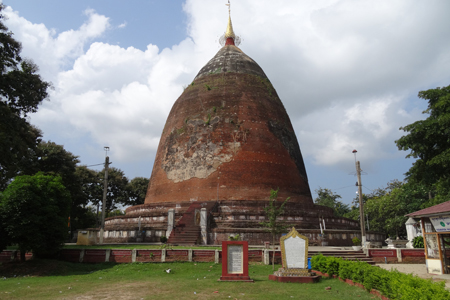
It is apparent that though Buddhism reigned supreme in Sri Ksetra Hinduism also influenced the cultural development of the Pyu. As a matter of fact, some elements of culture are common to both the religions and it is difficult to draw a clear-cut line between some of the customs and beliefs originating from these faiths. An example of this fact may be cited in the use in a profusion of coins or medals struck with auspicious symbols such as the srivatsa, vajra, conch, bhaddapitha, as also the emblems of the sun, the moon and the ocean represented by wavy lines.
The architectural, sculptural, epigraphic and artistic remains shed ample light on the cultural and religious aspects of the Pyu civilization. Unfortunately, important historical events are hardly obtained from archaeological sources. Thus we do not know for certain when and how this prosperous Pyu city met its final fate. Of course, Chinese records mention the sacking of a Pyu capital in 832 A.C. by Chinese hordes but it cannot be ascertained whether that capital was either Sri Ksetra or Halin, another contemporary city in the north. Anyway, it is evident that Sri Ksetra did begin to decline by the 9th century and when the Pyus gradually merged with Myanmar it gave way to Bagan to emerge as the capital of unified Myanmar in the 11th century.
